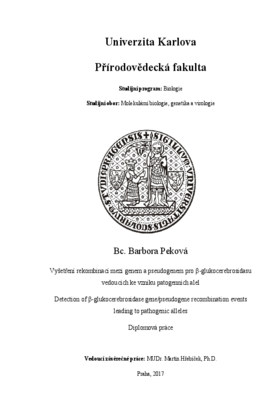Vyšetření rekombinací mezi genem a pseudogenem pro β-glukocerebrosidasu vedoucích ke vzniku patogenních alel
Detection of β-glucocerebrosidase gene/pseudogene recombination events leading to pathogenic alleles
diplomová práce (OBHÁJENO)

Zobrazit/
Trvalý odkaz
http://hdl.handle.net/20.500.11956/85687Identifikátory
SIS: 173649
Kolekce
- Kvalifikační práce [20153]
Autor
Vedoucí práce
Oponent práce
Schierová, Michaela
Fakulta / součást
Přírodovědecká fakulta
Obor
Genetika, molekulární biologie a virologie
Katedra / ústav / klinika
Katedra genetiky a mikrobiologie
Datum obhajoby
8. 6. 2017
Nakladatel
Univerzita Karlova, Přírodovědecká fakultaJazyk
Čeština
Známka
Velmi dobře
Klíčová slova (česky)
genová konverze, gen pro β-glukocerebrosidasu, pseudogen pro β glukocerebrosidasu, sekvenování nové generace, bodová mutaceKlíčová slova (anglicky)
gene conversion, β-glucocerebrosidase gene, β-glucocerebrosidase pseudogene, next-generation sequencing, point mutationCílem této diplomové práce bylo vypracovat přehled o genové konverzi, její roli v patogenezi lidských onemocnění a zhodnotit využití metod založených na sekvenování nové generace (NGS) pro detekci vzácných změn sekvence DNA. Jedná se o pilotní studii využití NGS pro detekci bodových mutací vznikajících de novo v genu pro β-glukocerebrosidasu genovou konverzí mezi ním a jeho pseudogenem v meiotických a mitotických buňkách kontrolních osob. Primery specifické pro aktivní gen byly použity pro selektivní amplifikaci úseku devátého a desátého exonu genu, kde se "rekombinantní" změny vyskytují nejčastěji. Byla využita metoda značení cílových molekul DNA pomocí náhodných sekvencí v primeru. Bioinformatickým zpracováním byly detekovány bodové mutace v sekvencích získaných z 20 vzorků genomové DNA na platformě Illumina MiSeq. Sekvence byly filtrovány, tříděny podle unikátního značení jednotlivých molekul DNA a byly vytvořeny alignmenty těchto sekvencí. Softwarovou detekcí se záměrně nestriktními kritérii bylo v jednotlivých vzorcích nalezeno 12-48 potenciálních bodových mutací, které byly následně ověřovány přehodnocením alignmentů sekvencí nesoucích shodnou značící sekvenci. Počet alignmentů s unikátním značením byl v rozmezí 7-15 tisíc na vzorek. Ve třech vzorcích byly nalezeny v genu pro...
This diploma thesis provides an overview of gene conversion, its role in the pathogenesis of human diseases and the use of methods based on next-generation sequencing (NGS) for detection rare variants of DNA sequence. Labeling of target DNA molecules by random nucleotides in primer and NGS were used for detection point mutations arising de novo in the β-glucocerebrosidase gene by gene conversion between it and its pseudogene in meiotic and mitotic cells of control subjects. Primers specific for the active gene were used to selectively amplify the ninth and tenth exon of the gene where "recombinant" variants occur most frequently. Sequences generated from 20 genomic DNA samples on Illumina MiSeq platform were quality filtered, sorted by unique labels and consensus sequences were created from alignments of sequences carrying the same DNA tag. The number of potential point mutations in the samples ranged between 12 and 48. The mutations were manually re-evaluated from the alignments. The number of alignments with unique labeling was in the range of 7-15 thousand per sample. Only three samples carried possible recombinant mutations, suggesting a lower frequency of conversion in the region than reported by other techniques. Analysis of unique sequences in primer indicated possible ways to improve the...
